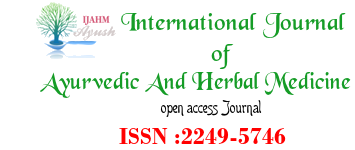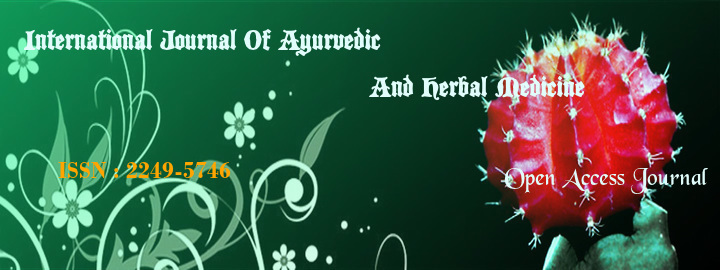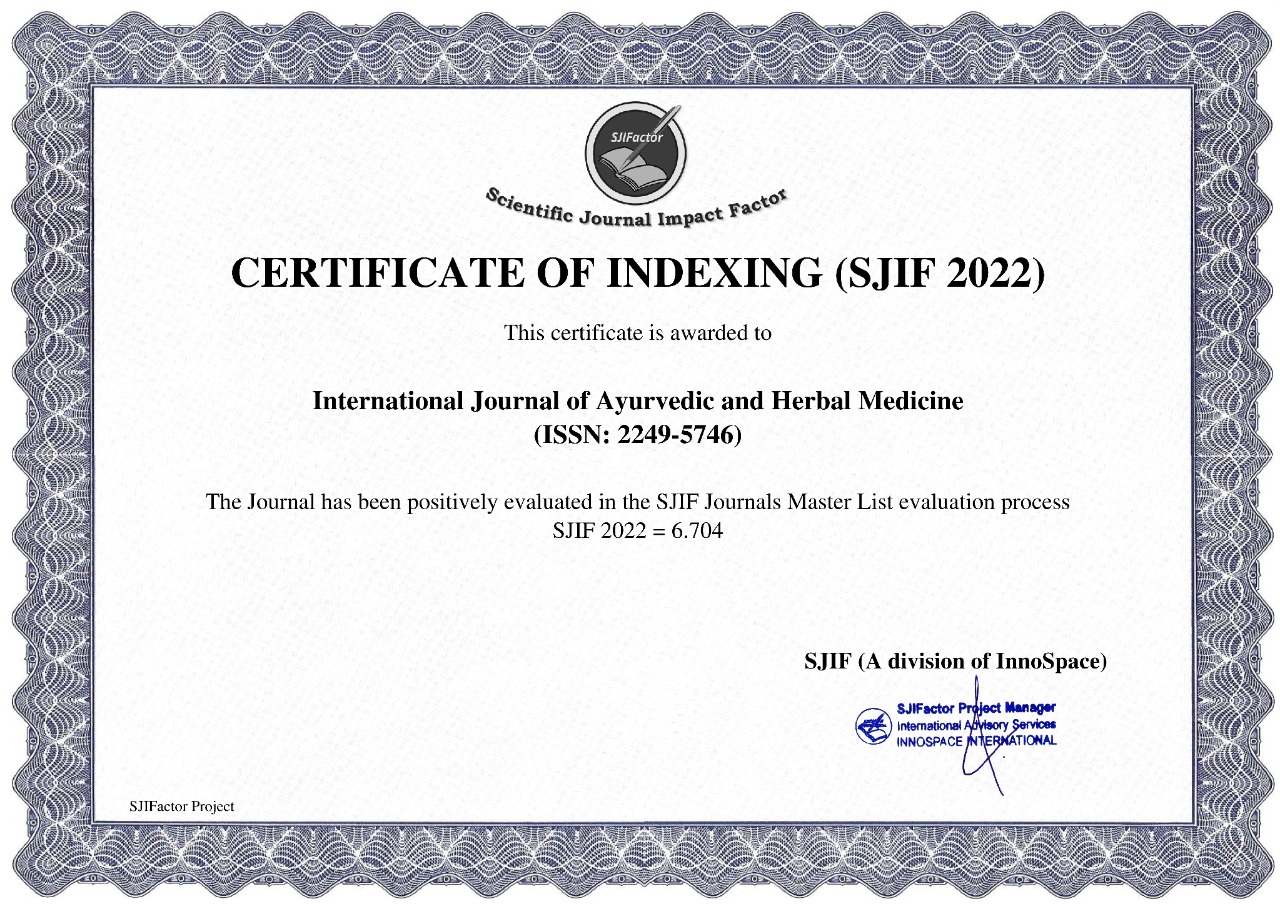


1Patekar Rashmi , 2 Jaiswal M.L. ,3 Neelam ,4 Choudhary Anubha, 5 Hivale Ujwala
DOI : http://dx.doi.org/10.18535/ijahm/v7i4.05
1Ph.D Scholar, P.G. Dept. of Dravyaguna Vigyan, National Institute of Ayurveda, Jaipur.
2.Associate Prof., P.G. Department of Dravyaguna Vigyan, National Institute of Ayurveda, Jaipur,
3.Ph.D Scholar, P.G. Dept. of Dravyaguna Vigyan, National Institute of Ayurveda, Jaipur,
4.M.D Scholar, P.G. Dept. of Dravyaguna Vigyan, National Institute of Ayurveda, Jaipur,
5.Ph.D Scholar, P.G. Dept. of Panchakarma, National Institute of Ayurveda, Jaipur
Corresponding Author:
Patekar Rashmi
P.G. Dept. of Dravyaguna Vigyan, National Institute of Ayurveda, Jaipur, Rajasthan, India.
ABSTRACT:
Traditional remedies are gaining worldwide acceptability. In the developing country like India safe, efficient and economic indigenous remedies are gaining popularity among the urban and rural areas. Diabetes is one of the major lifestyle disease which remains without a promising management solution in conventional medicine. In Ayurveda, this disease can be largely equated to a disease process called Prameha. The Western Ghats consists of unusual flora of Sahyadri hills representing dense and diversified vegetation. The people here are largely dependent on the available natural resources for food and medicine at primary level in treatment of diabetes. Not much work has been done so far for exploration of anti diabetic activity of these medicinal plants in correlation with its mode of action in perspective of Ayurveda texts and modern literature collectively. So the paper will highlight the anti diabetic potential of some selected medicinal plants used here for diabetic treatment through available Ayurveda literature and recent researches done so far.
Keywords- Traditional medicinal plants, Western Ghats (India), Anti diabetic potential, Prameha.
Reference
1. Agnivesha: Charaka Samhita, Ayurveda Dipika Commentary by Chakrapani, Ed. Pt. Y T Acharya: New Delhi, Rastriya Sanskrit Samsasthan; Reprint 2011, verse no Charaka Sutrasthana 26/12.
2. Agnivesha: Charaka Samhita, Ayurveda Dipika Commentary by Chakrapani, Ed. Pt. Y T Acharya: New Delhi, Rastriya Sanskrit Samsasthan; Reprint 2011, verse no Charaka Sutrasthana 26/71.
3. Definition, Diagnosis and Classification of Diabetes Mellitus and its Complications. Part 1: Diagnosis and Classification of Diabetes Mellitus (WHO/NCD/NCS/99.2). Geneva: World Health Organization; 1999.
4. Din N, Dibong SD, Mopondo Mopondo E, Priso RJ, Kwin NF et al. Inventory and Identification of plants Used in the Treatment of Diabetes in Doula Town (Cameroon), 2011; 1(3):60-73.
5. Patekar Rashmi, Jaiswal M.L., Survey of some traditionally used Anti diabetic Plants in Amboli region of Maharashtra, India in perspective of Ayurveda. Journal of Medicinal Plant Studies, 2017; 5(2): 343-347.
6. Patel S.S and Goyal R.K., Prevention of diabetes-induced myocardial dysfunction in rats using the juice of the Emblica officinalis fruit. Exp Clin Cardiol., 2011; 16(3):87-91.
7. 7]Kimura K., Role of essential trace elements in the disturbance of carbohydrate metabolism, Nippon Rinsho, 1996; 54: 79–84.
8. Subramanian V., Butler L.G., Jambunathan R. and Prasada Rao K.E., Some agronomic and biochemical characters of brown sorghums and their possible role in bird resistance. J. Agric. Food Chem., 1983; 31:1303-1307.
9. Rekha R. Deokar , Shubhangi R. Kamble , Satish R. Mane and Sarjerao R. Patil, Survey of Ethno medicinal Plants with Antidiabetic Potential from Chandoli, Dist. Sangli, (M.S.) India. Journal of Pharmacy Research, 2012; 5(2):1001-1003.
10. A.Maruthupandian and V.R. Mohan. Antidiabetic, Antihyperlipidaemic and Antioxidant activity of Pterocarpus marsupium Roxb. in alloxan induced diabetic rats. International Journal of PharmTech Research, 2011; 3(3):1681-1687.
11. Mishra A, Srivastava R, Srivastava SP, Gautam S, Tamrakar AK, Maurya R, Srivastava AK. Antidiabetic activity of heart wood of Pterocarpus marsupium Roxb. and analysis of phytoconstituents. Indian J Exp Biol. 2013; 51(5):363-74.
12. Manickam M, Ramanathan M, Farboodniay Jahromi MA, Chansouria JPN, Ray AB Antihyperglycemic activity of phenolics from Pterocarpus marsupium. J Nat Prod, 1997; 60:609-610.
13. Vidyasagar GM, Siddalinga Murthy S M, Medicinal Plants used in the treatment of Diabetes mellitus in Bellary district, Karnataka. Indian Journal of Traditional Knowledge, 2013; 12(4):747-751.
Mayurkumar Patel, Shrihari H Mishra, Hypoglycemic activity of alkaloidal fraction of Tinospora cordifolia, Phytomedicine: international journal of phytotherapy and phytopharmacology, 2011;
15. 15]Kinkar Shobha B., Patil Kishor Gopal. Anti diabetic Activity of Tinospora cordifolia (Fam. Menispermaceae) in Alloxan \ Treated Albino Rats. Applied Research Journal, 2015; 1(5): 316-319.
16. Nagaraja Puranik, Kararashah Fakruddin Kammar, Sheela Devi; Anti-diabetic activity of Tinospora cordifolia (Willd.) in streptozotocin diabetic rats; does it act like sulfonylureas?; Turk J Med Sci, 2010; 40 (2): 265-270.
17. Chandra Shekhar Singh, Amit Kumar Singh, Sonam Khandelwal, Ratanlal Vishwkarma. Anti-Diabetic Activity of Ethanolic Extract of Tinospora Cordifolia Leaves. Int. J. of Drug Discovery & Herbal Research, 2013; 3(1): 601-604.
18. K Aadhan and SP Anand, Survey of medicinal plants used for the treatment of diabetes by the Paliyar’s Tribe in Sadhuragiri hills, Tamil Nadu, India. International Journal of Herbal Medicine, 2017; 5(3):17-25.
19. Roman Adhikari, Jyoti Y, Deepika Bora, Vamsee Veena A, Combined Effect of Aqueous Extract of Curcuma longa Linn. with Metformin in Diabetes Induced Neuropathic Pain in Rats. Asian Journal of Pharmaceutical and Clinical Research, 2015; 8(5).
20. Kuroda M, Mimaki Y, Nishiyam T, Mae T, Kishida H, Tsukagawa M, Takahashi K, Kawade T, Nakagawa K, Kitahara M. Hypoglycemic effects of turmeric (Curcuma longa L. rhizomes) on genetically diabetic KK-Ay mice. Biol Pharm Bull., 2005; 28(5): 937-9.
21. A. Kumar, R. Ilavarasan, T. Jayachandran, M. Deecaraman, P. Aravindan, N. Padmanabhan and M. R. V.Krishan. Anti-diabetic activity of Syzygium cumini and its isolated compound against streptozotocin-induced diabetic rats. Journal of Medicinal Plants Research, 2008; 2(9): 246-249.
22. Saravanan G, Leelavinothan P. Effects of Syzygium Cumini Bark on Blood Glucose, Plasma Insulin and C-peptide in Streptozotocininduced Diabetic rats. Int J Endocrinol Metab., 2006; 4: 96-105.
23. Jayaprakasam B, Vareed SK, Olson LK, Nair MG. Insulin secretion by bioactive anthocyanins and anthocyanidins present in fruits. J Agric Food Chem, 2005; 53: 28-31.
24. Ong KC, Khoo HE. Effects of myricetin on glycemia and glycogen metabolism in diabetic rats. Life Sci., 2000; 67: 1695-705.
25. Dr.S.Vijayanand. Evaluation of Antidiabetic activity of Murraya koenigii on Alloxan Induced Diabetic rats. International Journal of Pharma Sciences and Research, 2015; 6 (12).
26. B. Dineshkumar , Analava Mitra, Manjunatha Mahadevappa. Antidiabetic and hypolipidemic effects of mahanimbine (carbazole alkaloid) from murraya koenigii (rutaceae) leaves. International Journal of Phytomedicine, 2010; 2: 22-30.
27. P.Durairaj & M.Kamaraj, Traditional Medicinal Plants Resources of Southern Panchchamalais in Trichirapalli DT Tamilnadu, India: Implication of Traditional Knowledge in Health Care System. IMPACT: International Journal of Research in Humanities, Arts and Literature, 2013; 1(6):39-46.
28. Nalamolu Koteshwar Rao. Anti-Hyperglycemic and Renal Protective Activities of Andrographis paniculata Roots Chloroform Extract. Iranian Journal of Pharmacolgy & Therapeutics, 2006; 5(1):47-50.
29. Ramya Premanath, Lakshmidevi Nanjaiah. Antidiabetic and Antioxidant potential of Andrographis paniculata Nees. leaf ethanol extract in streptozotocin induced diabetic rats. Journal of Applied Pharmaceutical Science, 2015; 5(1): 069-076.
30. Ramakrishna D, Shashank .A.T., Shinomol George. K., Kiran.S , and Ravishankar. G.A, ,Salacia Sps – A Potent Source of Herbal Drug for Antidiabetic and Antiobesity Ailments : A Detailed Treatise. International Journal of Pharmacolognosy and Phytochemical Research, 2015; 7(2).
31. Periyar Selvam Sellamuthu, Palanisamy Arulselvan, Balu Periamallipatti Muniappan. Effect of mangiferin isolated from Salacia chinensis regulates the kidney carbohydrate metabolism in streptozotocin–induced diabetic rats. Asian Pacific Journal of Tropical Biomedicine; 2012, 2(3):1583-1587.
32. Periyar Selvam Sellamuthu, Palanisamy Arulselvan, Balu Periamallipatti Muniappan, Sharida Fakurazi, and Murugesan Kandasamy. Mangiferin from Salacia chinensis Prevents Oxidative Stress and Protects Pancreatic β-Cells in Streptozotocin-Induced Diabetic Rats. Journal of Medicinal Food, 2013; 16(8): 719-727.
33. Balasubramanian Arul, Ramalingam Kothai a, Arokiasamy Josephine Maria Christina. Hypoglycemic Activity of Casearia esculenta Roxb. in Normal and Diabetic Albino Rats. Iranian Journal of Pharmaceutical Research, 2006; 5(1): 47-51.
34. Bhusal A, Jamarkattel N, Shrestha A, Lamsal NK, Shakya S, Rajbhandari S. Evaluation of antioxidative and antidiabetic activity of bark of holarrhena pubescens wall, 2014; 8(9).
35. D.D. Bandawane, K.H. Bibave, A.V. Jaydeokar, U.S. Patil and M.G. Hivrale.Antihyperglycemic and Antihyperlipidemic Effects of Methanolic Extract of Holarrhena antidysenterica Bark in Alloxan Induced Diabetes Mellitus in Rats. Pharmacologia, 2013; 4(2).
36. A Bakrudin Ali Ahmed, A.S Rao, M.V Rao. In vitro callus and in vivo leaf extract of Gymnema sylvestre stimulate β-cells regeneration and anti-diabetic activity in Wistar rats. Phytomedicine, 2010; 17(13):1033–1039
37. Nimisha Verma, V.K. Shakya and R.C. Saxena. Antidiabetic Activity of Glycoside Isolated from Gymnema sylvestre in Streptozotocin Induced Diabetic Rats. Asian Journal of Chemistry, 2008; 20(7): 5033-5036.
38. Sandhya Rani, Pallavi Mandave, Suresh Khadke, Suresh Jagtap, Shankar Patil1 and Aniket Kuvalekar. Antiglycation, Antioxidant and Antidiabetic activity of Traditional Medicinal Plant: Rubia cordifolia Linn. for management of Hyperglycemia. International Journal of Plant, Animal and Environmental Sciences, 2013; 3(3).
39. , , , and Effect of Aqueous Extract of Azadirachta indica (Neem) Leaves on Some Indices of Pancreatic Function in Alloxan-induced Diabetic Wistar Rats. Pharmacologia, 2012; 3(9).
40. Chattopadhyay RR. Possible mechanism of antihyperglycemic effect of Azadirachta indica leaf extract: part V. J Ethnopharmacol, 1999; 67(3):373–6.
41. Alsaif MA. Beneficial Effects of Rutin and Vitamin C Coadministration in a Streptozotocin-Induced Diabetes Rat Model of Kidney Nephrotoxicity. Pak J Nutr, 2009; 8(6):745–54.
42. Coskun O, Kanter M, Korkmaz A, Oter S. Quercetin, a flavonoid antioxidant, prevents and protects streptozotocin-induced oxidative stress and beta-cell damage in rat pancreas. Pharmacol Res., 2005; 51(2):117–23.
43. Karuna Rasineni, Ramesh Bellamkonda, Sreenivasa Reddy Singareddy and Saralakumari Desireddy. Antihyperglycemic activity of Catharanthus roseus leaf powder in streptozotocin-induced diabetic rats. Pharmacognosy Research, 2010; 2(3): 195–201.
44. Tiong SH, Looi CY, Hazni H, Arya A, Paydar M, Wong WF, Cheah SC, Mustafa MR, Awang K. Antidiabetic and antioxidant properties of alkaloids from Catharanthus roseus (L.) G. Don. Molecules, 2013; 18(8).
45. Bandawane D, Juvekar A, Juvekar M. Antidiabetic and Antihyperlipidemic Effect of Alstonia scholaris Linn. Bark in Streptozotocin Induced Diabetic Rats. Indian Journal of Pharmaceutical Education and Research, 2011; 45(2).
46. Gayathri Mahalingam, Krishnan Kannabiran. Hemidesmus indicus root extract ameliorates diabetes-mediated metabolic changes in rats. International Journal of Green Pharmacy, 2009.
47. Agnivesha: Charaka Samhita, Ayurveda Dipika Commentary by Chakrapani, Ed. Pt. Y T Acharya: New Delhi, Rastriya Sanskrit Samsasthan; Reprint 2011, verse no Charaka Chikitsasthana 6/4.
48. Agnivesha: Charaka Samhita, Ayurveda Dipika Commentary by Chakrapani, Ed. Pt. Y T Acharya: New Delhi, Rastriya Sanskrit Samsasthan; Reprint 2011, verse no Charaka Chikitsasthana 6/5-6.
49. Agnivesha: Charaka Samhita, Ayurveda Dipika Commentary by Chakrapani, Ed. Pt. Y T Acharya: New Delhi, Rastriya Sanskrit Samsasthan; Reprint 2011, verse no Charaka Sutrasthana 26/43-4.
50. Sushruta, Sushrutasamhita, with Nibandhasangraha Commentary Of Sri Dalhanacarya Ed. Vd. Yadavaji Trikamji Acharya & Narayana ram Acharya “Kavyatirtha”, Chaukhamba Orientalia, Varanasi; Reprint 2013, verse no Sushrut Sutrasthana 42/10-4.
51. Agnivesha: Charaka Samhita, Ayurveda Dipika Commentary by Chakrapani, Ed. Pt. Y T Acharya: New Delhi, Rastriya Sanskrit Samsasthan; Reprint 2011, verse no Charaka Sutrasthana 26/43-5.
52. Sushruta, Sushrutasamhita, with Nibandhasangraha Commentary Of Sri Dalhanacarya Ed. Vd. Yadavaji Trikamji Acharya & Narayana ram Acharya “Kavyatirtha”, Chaukhamba Orientalia, Varanasi; Reprint 2013, verse no Sushrut Sutrasthana 42/10-6.
53. Slobodan V., Jovanovic, Steen Steenken, Mihajlo Tosic, Budimir Marjanovic, Michael G. Simic. Flavonoids as Antioxidants. J.A.Chem.Soc., 1994; 116(11): 4846-4851.
index























